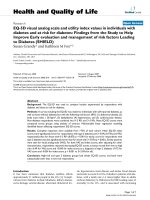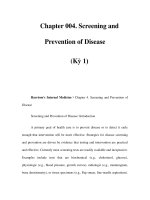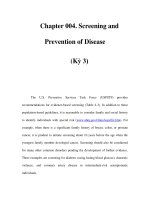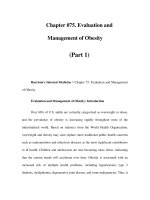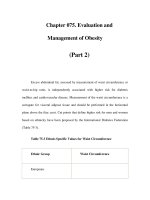Chapter 075. Evaluation and Management of Obesity (Part 3) pptx
Bạn đang xem bản rút gọn của tài liệu. Xem và tải ngay bản đầy đủ của tài liệu tại đây (67.99 KB, 5 trang )
Chapter 075. Evaluation and
Management of Obesity
(Part 3)
Assessing the Patient's Readiness to Change
An attempt to initiate lifestyle changes when the patient is not ready usually
leads to frustration and may hamper future weight-loss efforts. Assessment
includes patient motivation and support, stressful life events, psychiatric status,
time availability and constraints, and appropriateness of goals and expectations.
Readiness can be viewed as the balance of two opposing forces: (1) motivation, or
the patient's desire to change; and (2) resistance, or the patient's resistance to
change.
A helpful method to begin a readiness assessment is to "anchor" the
patient's interest and confidence to change on a numerical scale. Using this
technique, the patient is asked to rate his or her level of interest and confidence on
a scale from 0 to 10, with 0 being not so important (or confident) and 10 being
very important (or confident) to lose weight at this time. This exercise helps to
establish readiness to change and also serves as a basis for further dialogue.
Obesity: Treatment
The Goal of Therapy
The primary goal of treatment is to improve obesity-related comorbid
conditions and reduce the risk of developing future comorbidities. Information
obtained from the history, physical examination, and diagnostic tests is used to
determine risk and develop a treatment plan (Fig. 75-1).
The decision of how aggressively to treat the patient, and which modalities
to use, is determined by the patient's risk status, expectations, and available
resources. Therapy for obesity always begins with lifestyle management and may
include pharmacotherapy or surgery, depending on BMI risk category (Table 75-
5). Setting an initial weight-loss goal of 10% over 6 months is a realistic target.
Figure 75-1
Treatment algorithm.
This algorithm applies only to the assessment for overweight and obesity
and subsequent decisions on that assessment. It does not reflect any initial overall
assessment for other conditions that the physician may wish to perform. Ht,
height; Hx, history; Wt, weight. (From National, Heart, Lung, and Blood Institute:
Clinical guidelines on the identification, evaluation, and treatment of overweight
and obesity in adults: The evidence report. Washington, DC, US Department of
Health and Human Services, 1998.)
Table 75-5 A Guide to Selecting Treatment
BMI Category
Treatment 25–
26.9
27–
29.9
30
–35
35–
39.9
≥4
0
Diet, exercise,
behavior therapy
With
comorbiditie
s
With
comorbiditie
s
+ + +
Pharmacothera
py
With
comorbiditie
s
+ + +
Surgery With
comorbiditie
s
+
Source: From National Heart, Lung, and Blood Institute, North American
Association for the Study of Obesity (2000).



